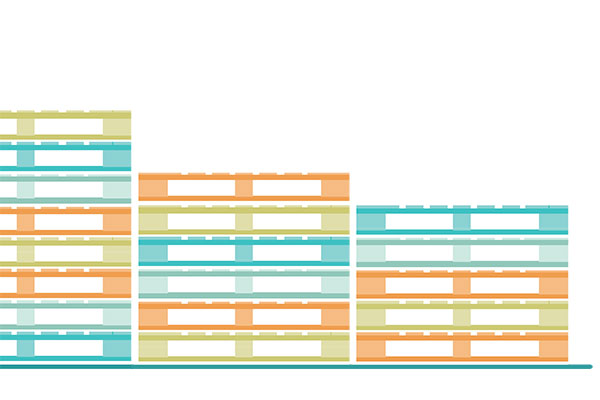Annual Pallet Report: 2020’s market evaluation
Modern’s latest reader survey shows just how critical pallets are to the modern warehouse and distribution center.
Pallets continue to play a crucial role in the warehouse and distribution environment, where they serve as platforms for the transport, storage and delivery of goods. They not only ensure that a maximum number of products fit on their platforms, but pallets also help keep those goods clean, protected and organized.
New or used, purchased or rented, and comprised of wood, plastic, metal or aluminum, pallets come in a range of styles and sizes. Always important, these warehousing mainstays have come in particularly useful in the Covid-19 environment, where the speedy loading and unloading of smaller orders has become table stakes.
For Modern’s 2020 survey of readers who use pallets, Peerless Research Group collaborated with the Center for Packaging and Unit Load Design at Virginia Tech to survey the magazine’s subscribers by e-mail invitation. We received 146 qualified responses from those employed at a location that uses pallets.
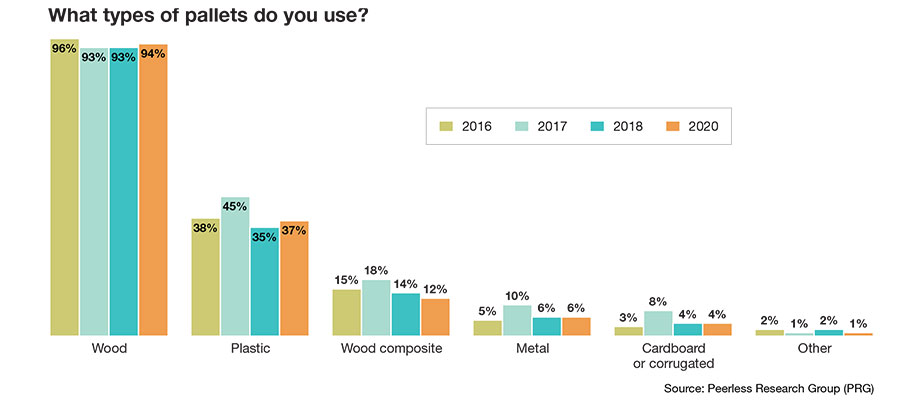
Most respondents (48%) work in manufacturing companies that make electrical equipment; fabricated materials; industrial machinery; paper/printing; and food, beverage and tobacco. The biggest portion work for companies with revenues of $10 million to $49.9 million (40%), under $10 million (21%), and $50 million to $99.9 million (10%).
Here are the key findings and some expert opinions on the important pallet-related trends taking place this year.
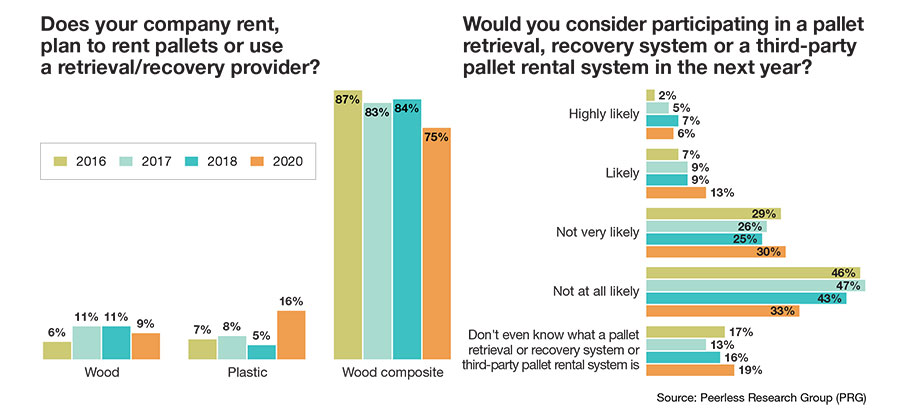
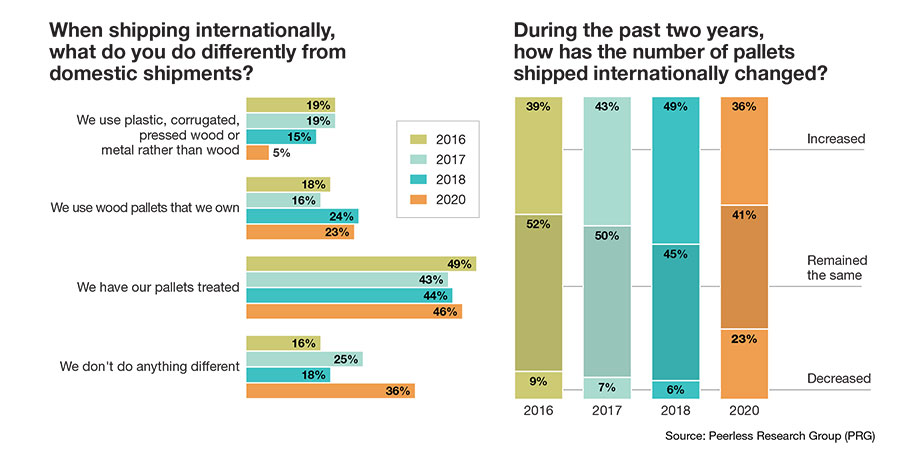
Standard wood pallets rule the roost
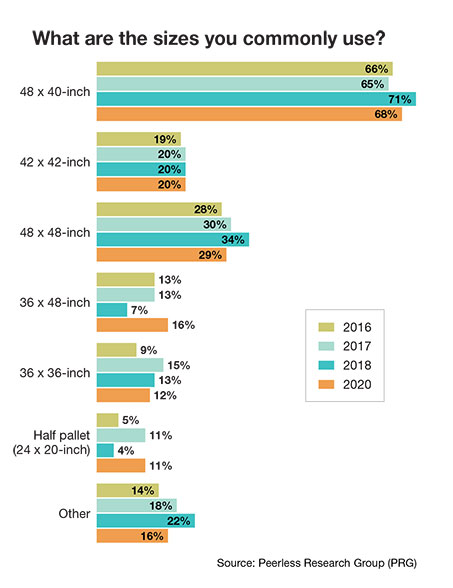 Nearly all (94%) of the companies surveyed are using wood pallets in their operations. This is pretty consistent with previous years’ surveys. Another 37% say they use plastic pallets and 12% use wood composite pallets, which saw a drop from 14% usage in 2018 and 18% in 2017. Another 6% of companies use metal pallets, 4% use cardboard or corrugated, and 1% use some other material.
Nearly all (94%) of the companies surveyed are using wood pallets in their operations. This is pretty consistent with previous years’ surveys. Another 37% say they use plastic pallets and 12% use wood composite pallets, which saw a drop from 14% usage in 2018 and 18% in 2017. Another 6% of companies use metal pallets, 4% use cardboard or corrugated, and 1% use some other material.
Most (72%) companies are using pallets to ship corrugated boxes, with bags (21%), drums (10%), pails (9%) and plastic totes/reusable plastic containers (RPCs) (6%) rounding out the lineup of packaging that’s typically shipped or received on pallets.
As far as pallet size goes, the majority (68%) of respondents use the standard 48 x 40-inch version. Twenty-nine percent use a slightly larger 48 x 48-inch square pallet, while 20% use 42 x 42-inch pallets. In 2018, 7% of respondents said they were using 36 x 48-inch pallets, which saw a usage increase in 2020 to 16%. Alternatively, 12% use 36 x 36-inch, 11% employ half pallets (24 x 20-inch), and 16% utilize a different size not listed on the survey.
“The obvious dominance of 48 x 40-inch pallets is pretty clear,” says Laszlo Horvath, director of Virginia Tech’s Center for Packaging and Unit Load Design, who suspects that some shippers are using this “standard” pallet size for a variety of loads and even some that would fit on a smaller platform.
For example, 41% of respondents say they use 48 x 40-inch pallets for shipping plastic, metal or fiber drums. “It’s difficult to put drums on a pallet of that size,” says Horvath. “In most cases, they’re probably just putting one or two drums on and leaving the rest of the platform empty.”
Wood pallet usage
In 2020, used wood pallets surpassed new ones in the race to stake a claim in the modern warehouse. Currently, 61% of respondents rely on used or core pallets; 53% are using new pallets; and 24% utilize a pallet pool. Although used pallets are more popular, they do present some procurement challenges. For example, 27% say used wood pallets are in short supply.
When it comes to quality, 36% of survey respondents admit the quality of used wood pallets isn’t as good as what they get from new pallets. However, 40% of those that rely on used wood pallets say they have not experienced any issues or do not anticipate any issues procuring them.
Over the last year, 42% of companies say that their use of used wood pallets has been consistent, while 27% say they used more than they did a year ago, and 31% are using less than they did one year ago.
Deploying plastic pallets
More than half of the respondents (63%) say their plastic pallet usage hasn’t changed in the last year, while 22% are using fewer plastic pallets and 15% are using more of them. Over the next year, 17% expect their usage of plastic pallets to increase while 16% expect a decrease and 65% say their usage will stay the same.
Of those companies that do anticipate an increase in their plastic pallet use, 31% say it’s due to durability, 31% say it’s because of compliance, 19% feel plastic is more sustainable than wood, and 16% say it’s because their customers are asking for them. Another 13% also feel they have greater control over plastic pallets versus other materials.
Rent or buy?
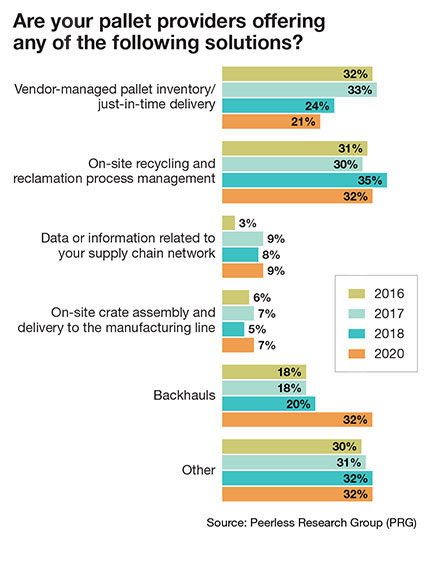 Asked whether their company rents, plans to rent, or uses a pallet retrieval/recovery provider, 75% said “no”—a number that fell from 84% in 2018. Sixteen percent say they use another type of pallet retrieval or recovery system, up from 5% in 2018. This year, 9% of respondents are using a pallet rental company, down from 11% in 2018.
Asked whether their company rents, plans to rent, or uses a pallet retrieval/recovery provider, 75% said “no”—a number that fell from 84% in 2018. Sixteen percent say they use another type of pallet retrieval or recovery system, up from 5% in 2018. This year, 9% of respondents are using a pallet rental company, down from 11% in 2018.
Currently, just 6% of companies say participating in a pallet retrieval, recovery system or a third-party pallet rental system over the next 12 months is “highly likely.” Thirteen percent say it is likely they will use one of these systems, up from only 8% in 2018. However, many companies are wary of these systems, with 29% saying it’s not very likely and 33% saying it’s not at all likely (down from 43% in 2018). According to the survey, 19% of respondents are unfamiliar with pallet retrieval, recovery systems and third-party pallet rental systems.
Domestic vs. international
In 2018, about half of companies were shipping their pallets domestically. For 2020, the number increased to 66%. Only 2% ship their pallets internationally, while 33% say they do both, which is a large decrease from 47% in 2018. Some of the shift is likely due to the pandemic and the impacts it’s had on global supply chains.
For the most part, companies are shipping to Canada and Mexico, South America and the Caribbean. The number of organizations shipping pallets to China, Japan, Southeast Asia, North Asia and Australasia has dropped to 33% (down from 50% in 2018), again most likely due to the ongoing impacts of the pandemic. For European shipments, 48% ship to Western Europe (up from 38% in 2018) and 24% ship to Eastern Europe (down from 29% in 2018).
In 2020, about 10% of companies are shipping pallets to the Middle East and North Africa—down from 21% in 2018. Over the next two years, 36% of companies expect an increase in the number of pallets that they’re shipping internationally (versus 46% in 2018). Another 59% say their international shipments will hold steady and just 5% expect a decrease.
When shipping internationally, many organizations take special precautions with their palleted goods. Almost half (49%), say they have their pallets treated when shipping internationally, and 23% use wood pallets that they own. Five percent of respondents use plastic, corrugated, pressed wood or metal—rather than wood—when shipping internationally, down from 15% that said they used these alternatives in 2018.
Over the past two years, 23% of companies say the number of pallets shipped internationally has decreased (versus 6% in 2018). Forty-one percent say their number of pallets shipped internationally remained the same, while 36% increased that volume over the past two years.
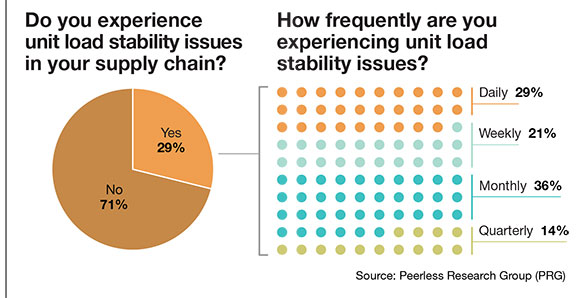
Packaging and wrapping
Asked what percentage of unit loads shipped/received by their company are stabilized, 60% say their loads are stabilized with stretch film and 40% say shrink film. Horvath says there could be some confusion over the definitions for these two terms, as most companies are using stretch—not shrink—film in their fulfillment operations.
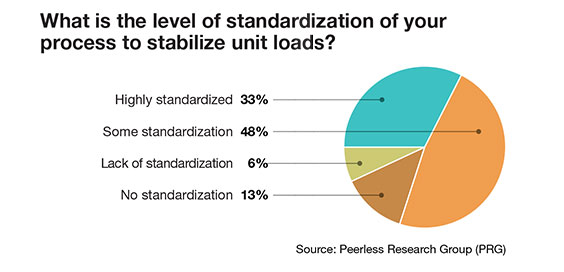
Forty percent of respondents say they use strapping/banding to stabilize loads, 11% use tie sheets, 5% use Lock’n Pop Adhesive, and 5% use a shrink hood. When it comes to manual and automated stretch wrapping, 41% of organizations manage all of their wrapping manually, while 31% have some automated stretch wrappers. Only 20% say all of their operation uses semi- or fully automated stretch wrappers, and 9% don’t use any stretch wrapping at all.
Horvath, who has personally seen the manual stretch film application on a single pallet take an hour or more, says nearly all companies would benefit from at least some type of semi- or fully automated stretch wrapping mechanism. “These machines aren’t a very big investment,” he says, “but they save considerable time spent manually wrapping pallets.”
Additional offerings
In assessing offerings from pallet providers, 21% say their providers offer vendor managed pallet inventory/just-in-time delivery, which is down from 24% in 2018 and 33% in 2017. However, 42% of respondents say they would be interested in receiving that service if it were available.
In addition, 32% say providers offer on-site recycling and reclamation process management, and 9% say they offer data or information related to their supply chain network. Thirty-two percent say their providers offer backhauls, compared to only 20% in 2018. The interest in backhauls from manufacturers has also gone up from 15% in 2018 to 23% in 2020.
Load stability has been a bigger challenge in 2020, with 29% of companies saying they experience unit load stability issues in their supply chain, while 71% do not. Of those that do, 29% experience unit load stability issues daily, 21% experience them weekly, 36% experience them monthly, and 14% experience them quarterly.
When asked about the level of standardization to stabilize unit loads, almost half (48%) say they use some standardization, while 33% say they only have some standardization, 13% say they have no standardization at all, and 6% reported a lack of standardization.
“The fact that 30% of companies have daily issues with load stability is pretty eye-opening,” Horvath points out. He sees the low usage numbers for automated stretch wrappers—and the fact that 13% of companies lack processes for handling load stability—as two key factors in this high number. “Without standardized, well-defined processes in this area, the chances that you’re going to have a stabilization problem are pretty good.”
Future outlook
In assessing the use of the Internet of Things (IoT) in relation to pallets, about 4% of respondents say they have a current business need that could be satisfied using IoT-enabled pallets in their supply chains. As modern technology continues to advance, Horvath expects the number of companies interested in IoT-enabled pallets to increase.
“Not everyone understands that IoT allows you to extract data from your pallets, whether the routes are causing product damage, or what percentage of your shipments are being subjected to harsh conditions,” Horvath adds. “Eventually, more companies will recognize this and as that happens, interest in IoT will grow.”

Article Topics
Shipping Pallets News & Resources
Two voices of reason on pallet materials Pallet recycler and services company PLA appoints Steve Clark as CEO Cobot as key ingredient for palletizing efficiency CHEP appoints Xavier Garijo to newly created CEO Americas position Pallet company Kamps announces executive team changes PLA names Jenny Bedard as new CFO Moving pallets at Aurobindo More Shipping PalletsLatest in Materials Handling
Registration open for Pack Expo International 2024 Walmart chooses Swisslog AS/RS and software for third milk processing facility NetLogistik partners with Vuzix subsidiary Moviynt to offer mobility solutions for warehouses Materials Handling Robotics: The new world of heterogeneous robotic integration BSLBATT is looking for new distributors and resellers worldwide Lucas Watson appointed CSO for Körber’s Parcel Logistics business in North America Hyster recognizes Dealers of Distinction for 2023 More Materials HandlingAbout the Author
Subscribe to Materials Handling Magazine

Find out what the world's most innovative companies are doing to improve productivity in their plants and distribution centers.
Start your FREE subscription today.
April 2024 Modern Materials Handling

Latest Resources


